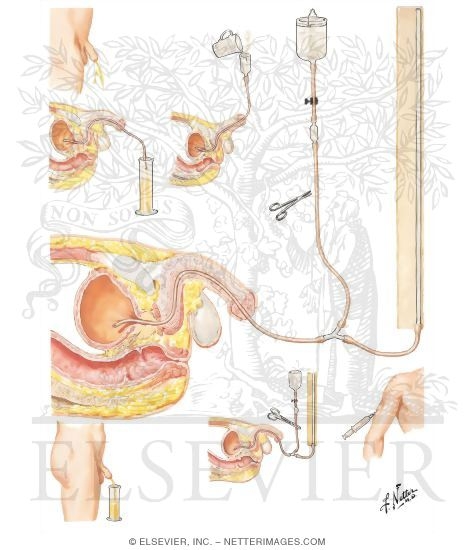Upper UT obstruction :
Renal, ureteric calculi
Pelvi-ureteric junction obstruction
Retroperitoneal fibrosis (idiopathic, malignancy)
Transitional cell carcinoma
Congenital (Ectopic ureter, ureterocele)
Infections (Schistosomiasis, TB)
Lower UT obstruction :
Urethral causes (stricture, tumour, stone)
Prostate (BPH, CA prostate)
Bladder neck (CA, stones, neurological causes, stricture)
What are the clinical features of acute urinary retention?
Patient usually complains of suprapubic pain, unable to pass urine
Well aware that there's bladder distension
On examination, bladder is palpable with the following features :
An ovoid mass originating from the pelvis
Can't get below the swelling
Tense, tender, smooth surface
Gentle pressure increases desire to micturate
Immobile
Percussion - dull
Positive fluid thrill
Sometimes, the bladder can be extending up to the umbilicus
(in cases of acute on chronic urinary retention)
What are the clinical features of chronic urinary retention?
Bear in mind that there're 2 types of chronic UR :
a) High pressure type
Associated with chronic bladder outflow obstruction
Can progress to hydroureter and hydronephrosis and eventually, obstructive renal failure
b) Low pressure type
Associated with bladder atony
Doesn't progress towards renal failure
Symptom-wise, patient is usually unaware that there's bladder distension
Usually, such condition is painless
However, there's both obstructive and irritative symptoms of micturition (as in BPH)
And, there's overflow incontinence :
The patient can pass an apparently normal volume of urine
However, whenever there's raised intra-abdominal pressure, there's dribbling of urine
On examination :
Bladder is usually palpable, upto the umbilicus
Non-tender, not tense
Gentle pressure may not be associated with any increased desire in micturition
Dull note on percussion, +ve fluid thrill
Briefly discuss about the clinical significance of urodynamic studies
The maximum urinary flow rate can be determined by urodynamic studies.
In men, it's 15-30 ml/sec; in females, it's 20-40 ml/sec.
A graph of urinary flow rate versus time can be plotted, in which different pattern of curves usually indicates different causes of obstruction.
A normal urinary flow : Rises to the peak rapidly, and rapidly drops down to the baseline (as shown above)
In bladder outflow obstruction, there's prolonged rise to poor maximum flow rate and periods of prolonged variability in flow rate
In urethral obstruction, there's a stable, plateu-shaped curve, with prolonged flow rate.
Together with cystometry, the bladder capacity, capacity during desire to micturate, pressure on the detrusor muscle in full bladder, residual urine volume can be determined.


ReplyDeleteGood information thanks for sharing Best urology hospital in hyderabad